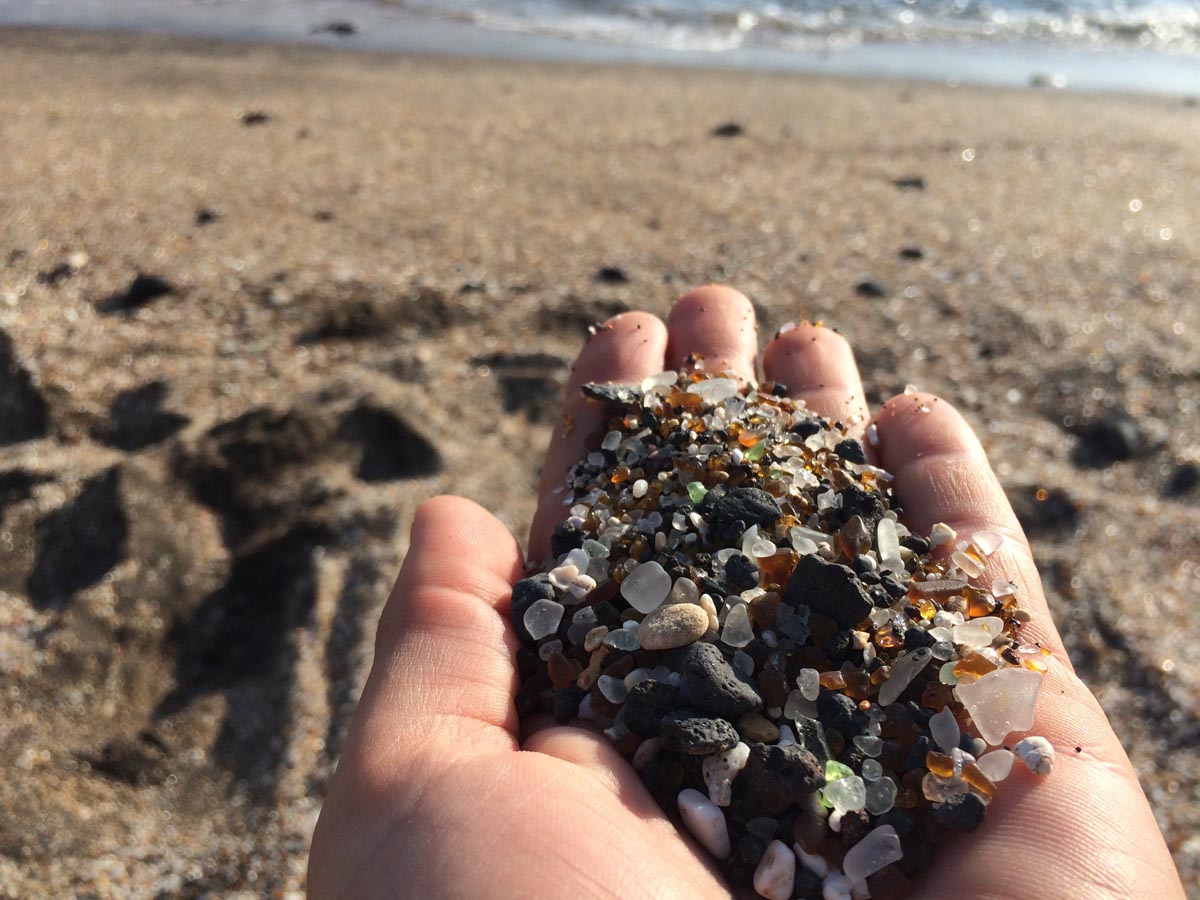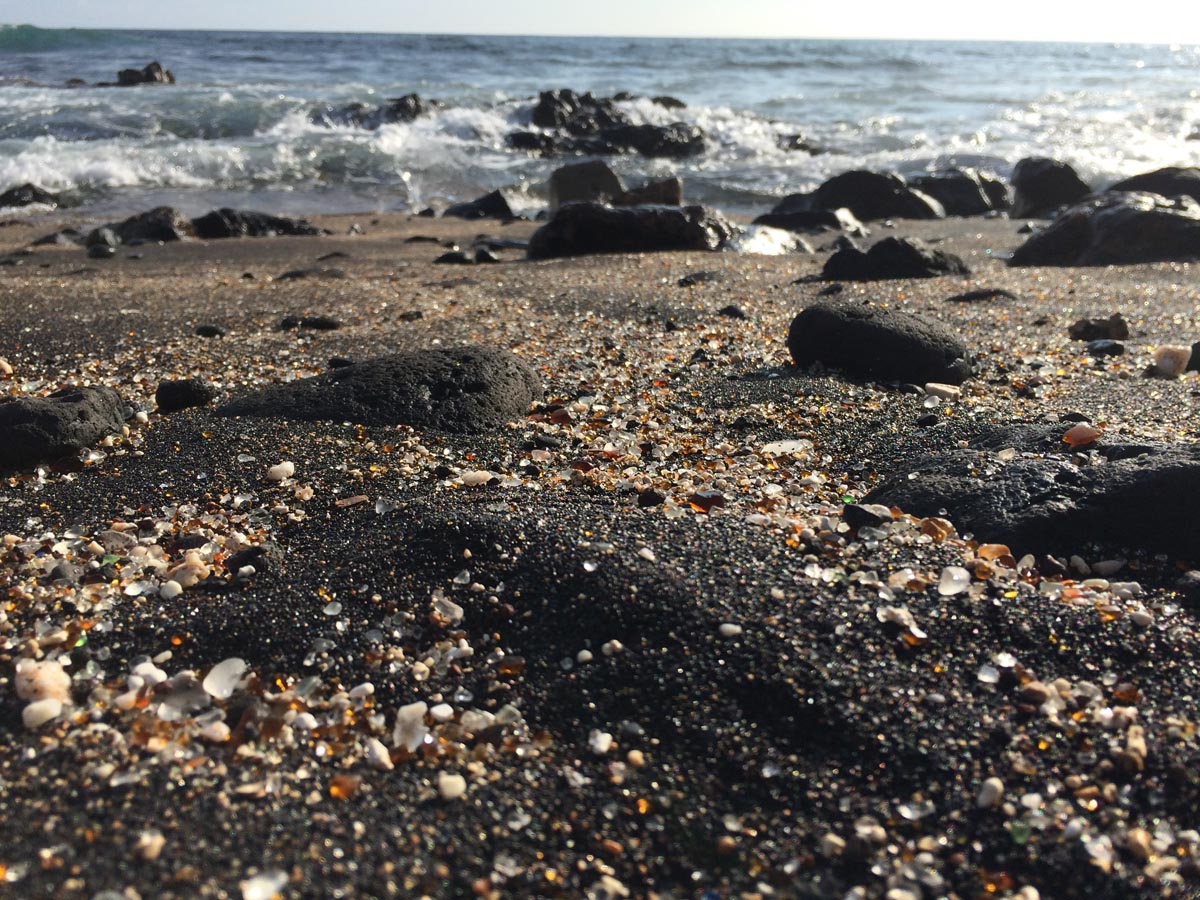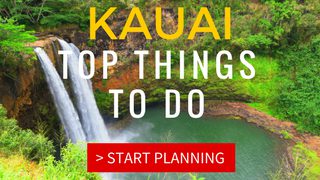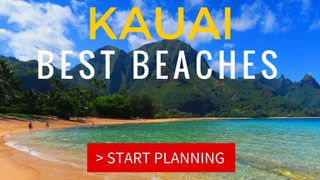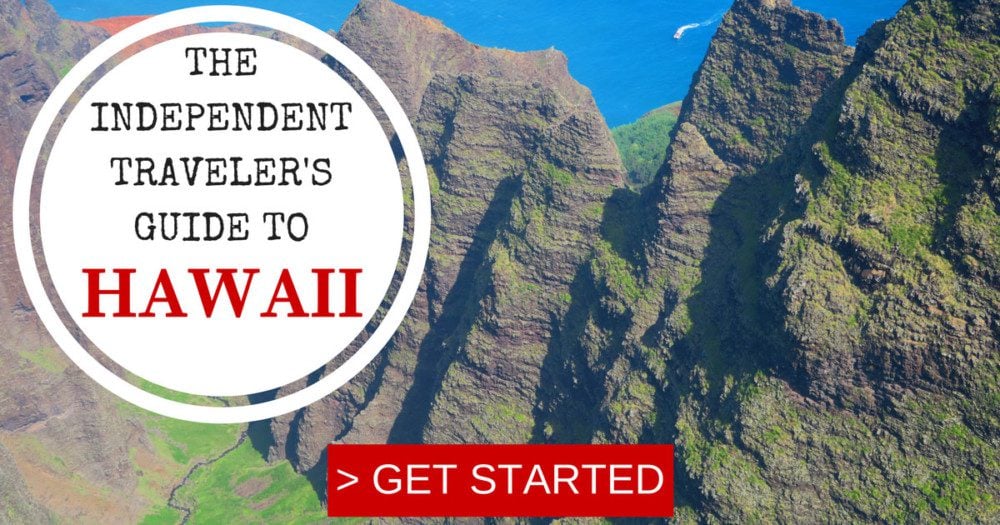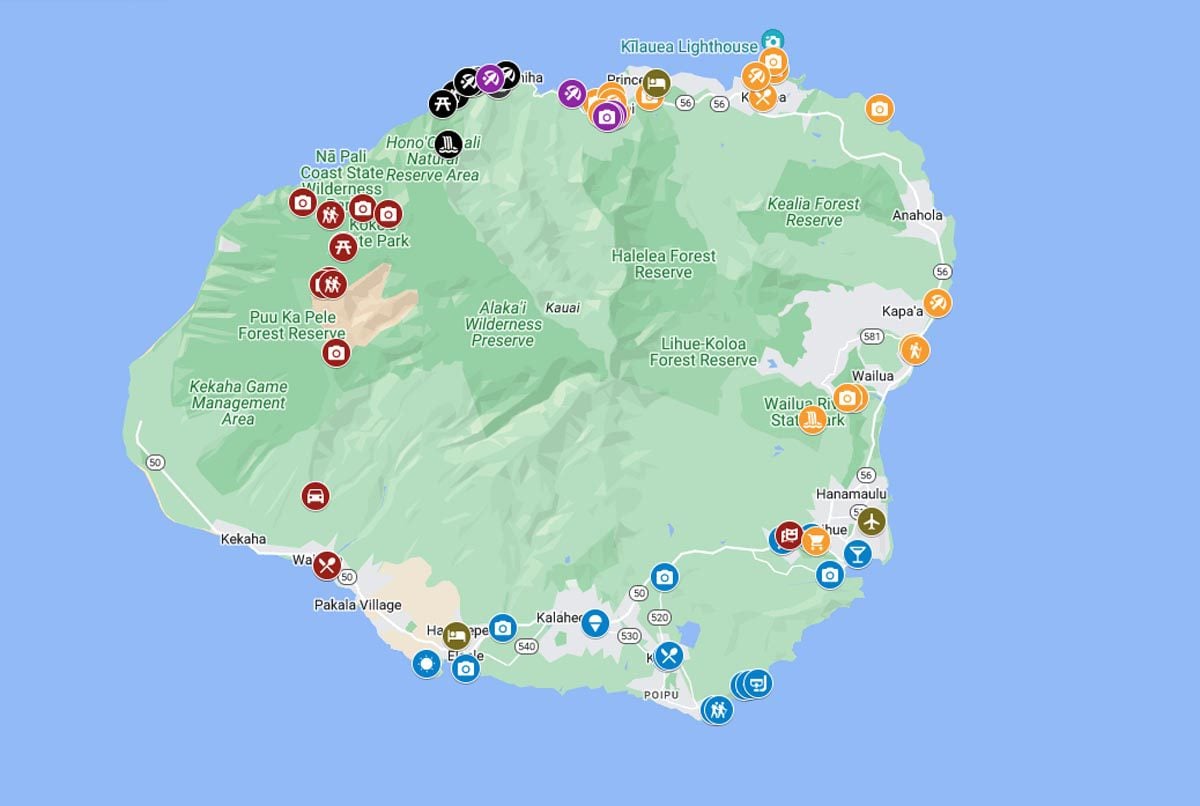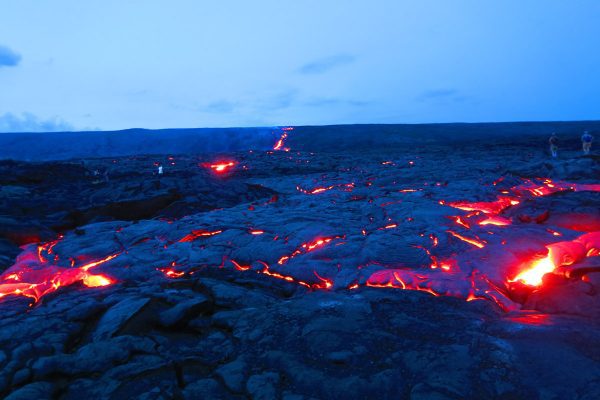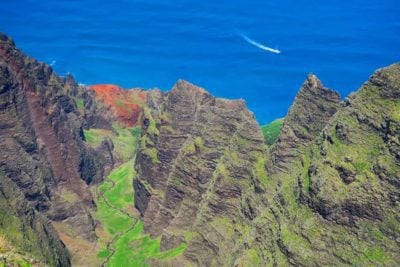5 Days In Kauai itinerary
The most stunning of the Hawaiian Islands, it is easy to understand why Hollywood comes to Kauai when searching for a paradise setting. Known as the “Garden Isle”, a simple drive to the supermarket becomes a scenic affair on the oldest island in Hawaii. Given all this time, Mother Nature has managed to sculpt Kauai’s lush peaks into artwork and created a wealth of dream beaches to choose from. This in-depth Kauai itinerary ensures you see the very best of the island in up to five days.
I spent 10 action-packed days in Kauai while touring the main Hawaiian Islands. It’s important to note that, as on other islands in the state, Kauai’s tour operators offer visitors an enormous choice of paid activities and organized tours. In this sample itinerary, we’ll stick to the basics, showing you the best of the island with little to no organized activities.
- Day 1: Essential Kauai Tips, Lihue, Poipu and Hanappepe [Current Page]
- Day 2: Waimea Canyon and koke’e State Park
- Day 3: Lihue to Hanalei Bay
- Day 4: Na Pali Coast, Kalalau Trail & Tunnels Beach
- Day 5: Relax on North Shore Beaches
Looking for a Quick Read?
Visiting other Hawaiian islands? Sample itineraries, guides to the best beaches, and lots more are waiting for you in the Hawaii Travel Guide collection. Aloha!
Why Visit Kauai?
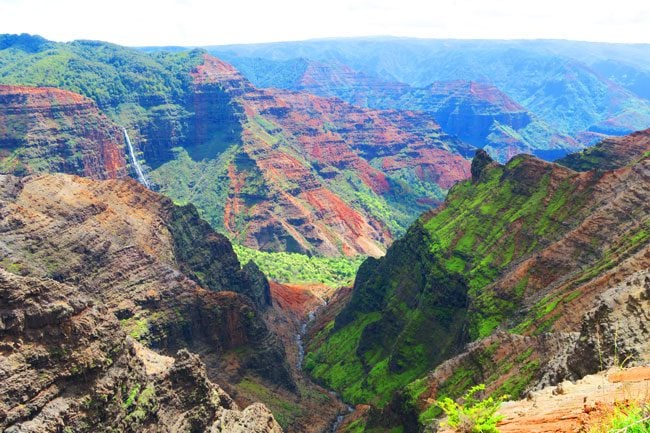
There’s a good reason why Hollywood often heads to Kauai to shoot scenes of a tropical paradise.
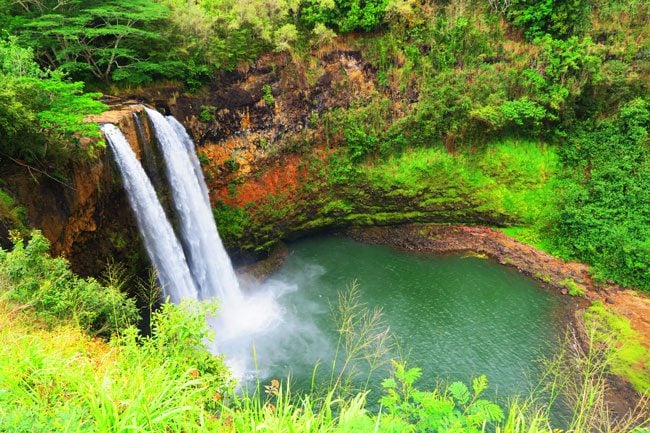
Everything grows in abundance on the Garden Isle and heavy downpours mean waterfalls galore.
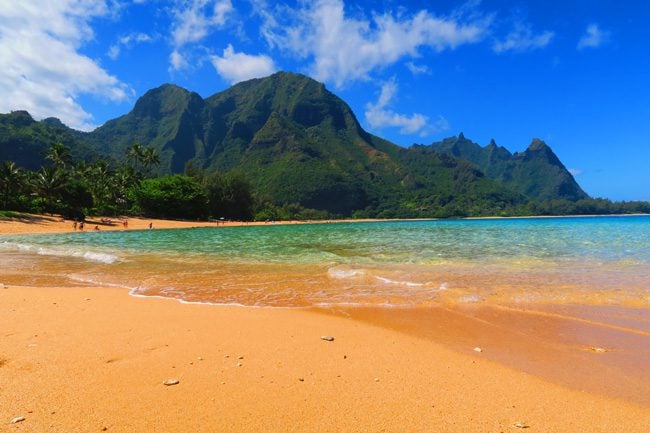
Breathtaking beaches and exceptional hiking opportunities are some of the excuses for leaving your hotel room behind.
Kauai itinerary Map
This companion map features all the places mentioned in this Kauai itinerary. Click on the image to open in Google Maps.
Kauai Travel Tips
This section of the Kauai itinerary covers essential travel tips for planning a trip to Kauai. Don’t forget to review the Hawaii planning tips guide, where you’ll find general advice on visiting the Hawaiian Islands.
When is the Best Time to Visit Kauai?
The weather and peak tourist season are the most important factors when planning a visit to Kauai.
Kauai’s Weather
Kauai is certainly worthy of its nickname – “The Garden Isle”. It is as green as it is thanks to enormous amounts of rain, which soak (and erode) its jagged peaks and lush valleys throughout the year. Kauai’s interesting weather patterns are covered in more depth later on. Generally, Kauai experiences drier weather during the North American summer and wetter conditions from November to March.
peak tourist season
Kauai gets a lot of visitors… seriously, a lot of visitors. It is a busy place throughout the year. Roads are often congested even out of peak season. Unless you absolutely have to, avoid traveling to Kauai during the U.S. school holidays or the official summer tourist season. During these times, the island will be even busier, travel times multiplied, and accommodations either fully booked or extremely expensive.
The bottom line
The best time to travel to Kauai is in the ‘shoulder season’ (March-May and September-October) when the weather is pleasant and the island is not too congested.
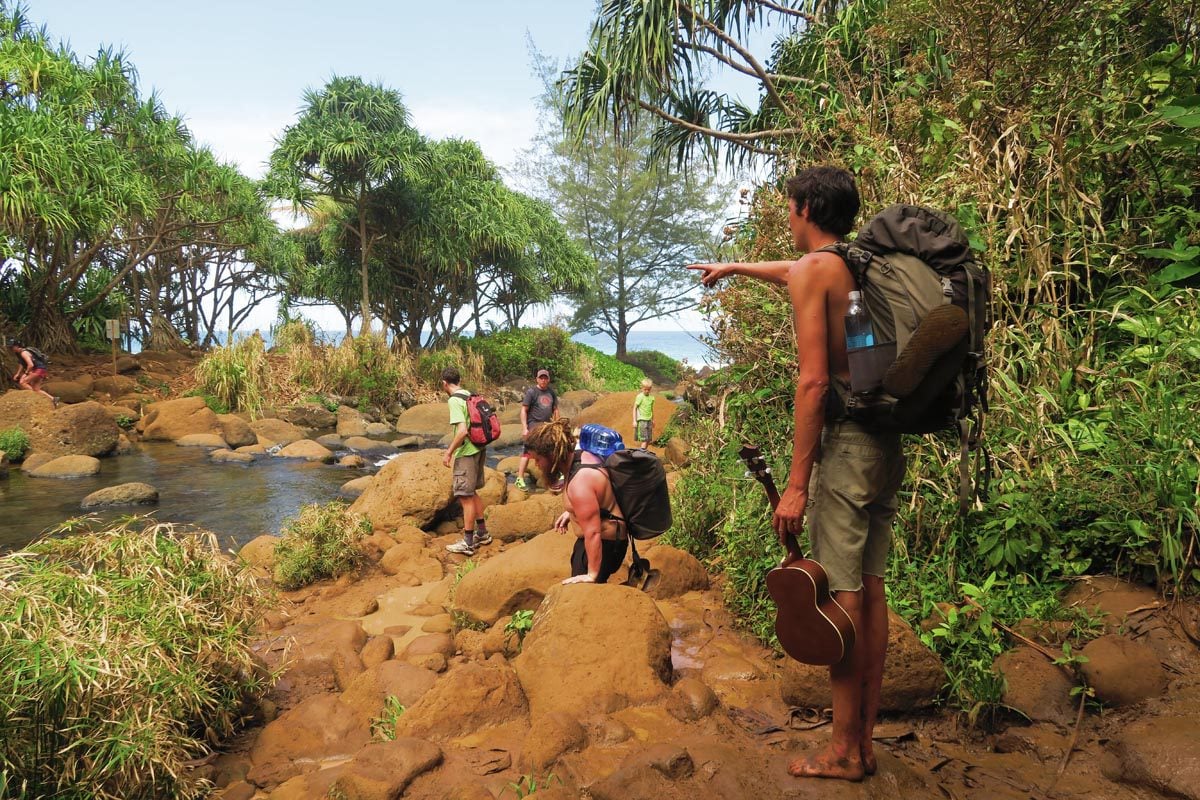
Where to Stay in Kauai?
Kauai has three main “hubs” to consider: the south shore (Poipu-Hanapepe-Waimea), the north shore (Princeville-Hanalei), and the central coast (Lihue-Kapa’a). If you plan to do serious sightseeing in Kauai, staying around the central coast is optimal when you factor in driving distances and road congestion. However, the north and south shores are the Kauai’s prettiest sections.
So, if you nonetheless want to stay in the north or the south, either rise early when sightseeing on the opposite side of the island or split your time in Kauai between the north and south shores. Kauai is always in short supply of mid-range and budget accommodations, so I strongly advise booking your accommodation as soon as possible.
Kauai’s North Shore vs. South Shore
The leeward Kauai south shore (Poipu-Hanapepe-Waimea) generally sees a lot more sunshine than the wetter and tropical windward north shore (Princeville-Hanalei). So, if your Kauai holiday is geared more around beaches or if you don’t mind the driving times, the south shore is probably where you want to spend most of your time. That said, the north shore is where you’ll be closer to Kauai’s dramatic eroded peaks, and it is often quite cloud-free in the mornings.
If you’re planning to book a Na Pali boat tour, take note that most tours depart from either Hanalei in the north shore, or from Port Allen in the south shore. To avoid a long drive, book a tour that fits well with your itinerary and accommodation location.
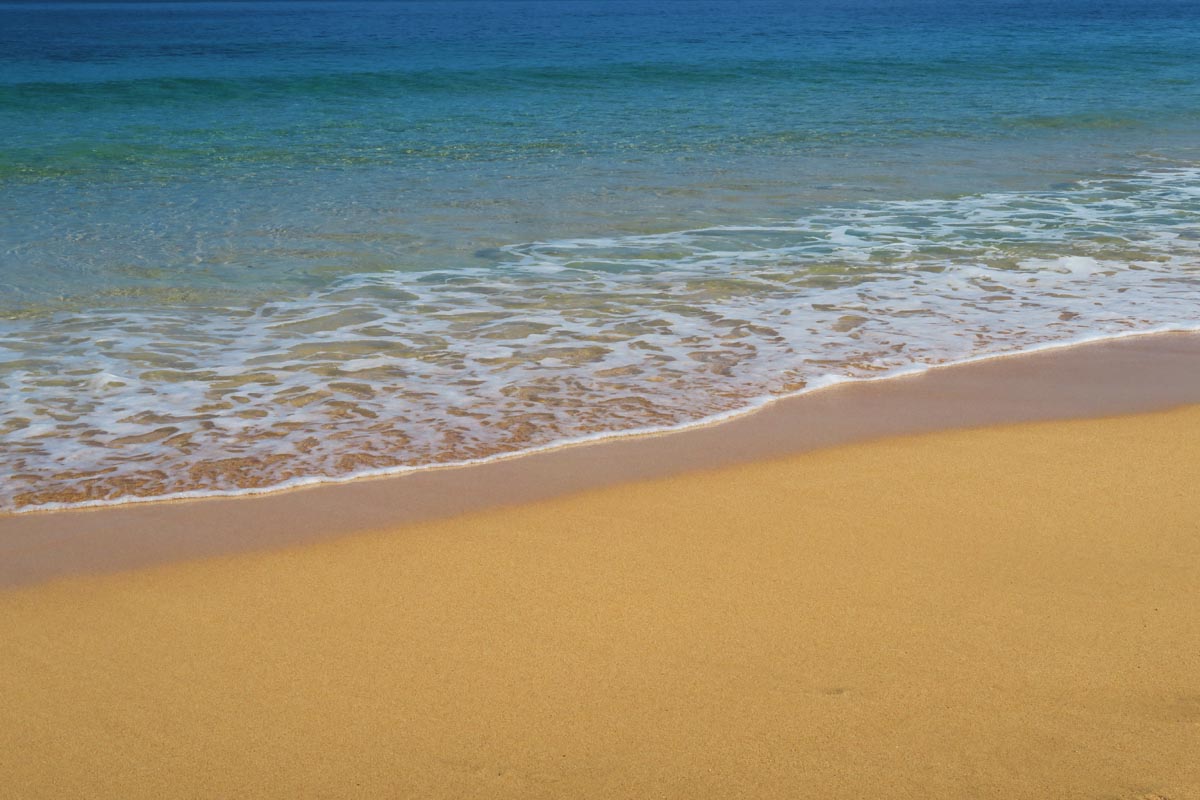
Accommodation Types in Kauai
Kauai does have several resorts (though nothing like Maui), mainly around Poipu, Princeville, and Kapaa. Bed and breakfasts are in short supply, backpacker hostels are in bad condition, and there are plenty of Airbnbs, though the good ones get snatched quickly. Get your Kauai camping permit well in advance if you’re into camping.
You will also find a lot of condos for rent. Those are more or less proper apartments usually in some kind of timeshare resort or vacation rental community. When renting condos and staying at bed and breakfasts, you can expect to have a cleaning fee added to your bill. This can range from $50 per stay up to $200. It’s annoying and makes no sense, but it is a common practice, especially in Kauai and Molokai.
Princeville
I mainly stayed at the Wyndham Ka ‘Eo Kai in Princeville. The location is near perfect, inside the lush grounds of the Princeville resort area (featured in the film The Descendants) and close to the charming village of Hanalei and the north shore beaches. Units are modern and spacious and feel more like a home than a resort. There’s a swimming pool, BBQ facilities, tennis courts, daily free activities, and everything you would expect to have at this sort of place.
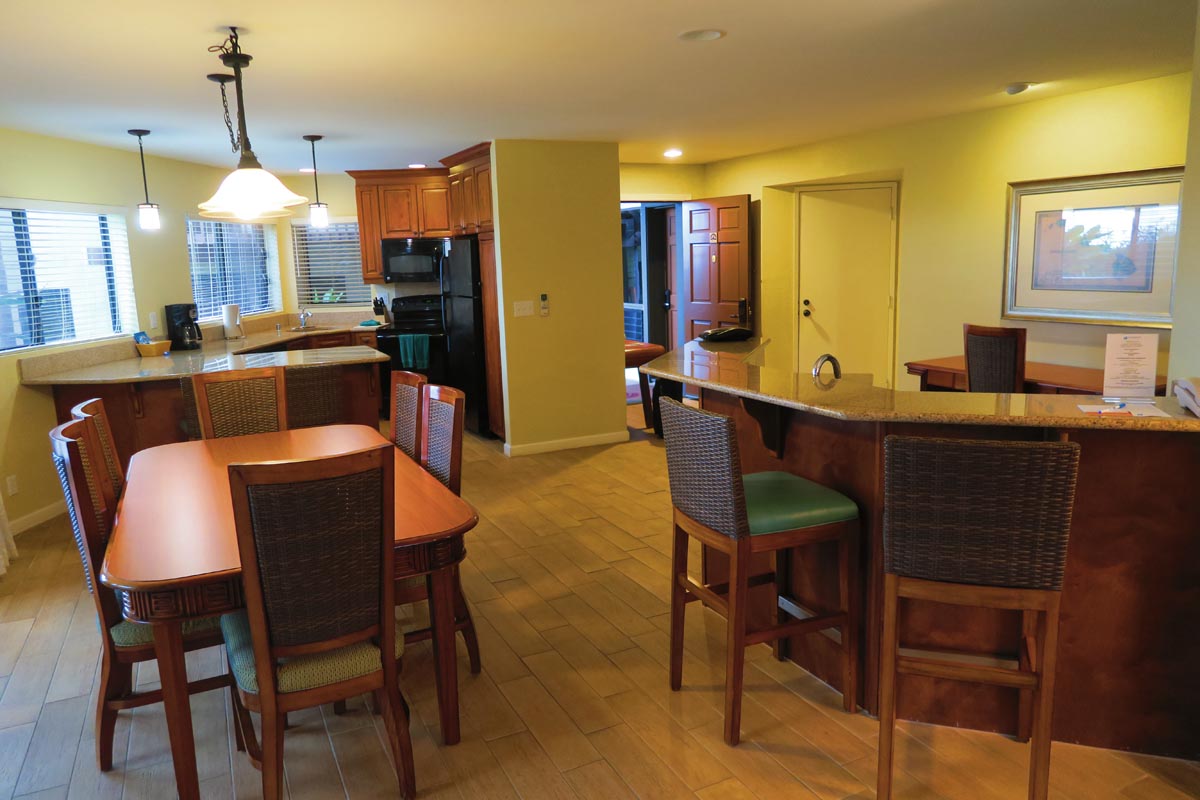
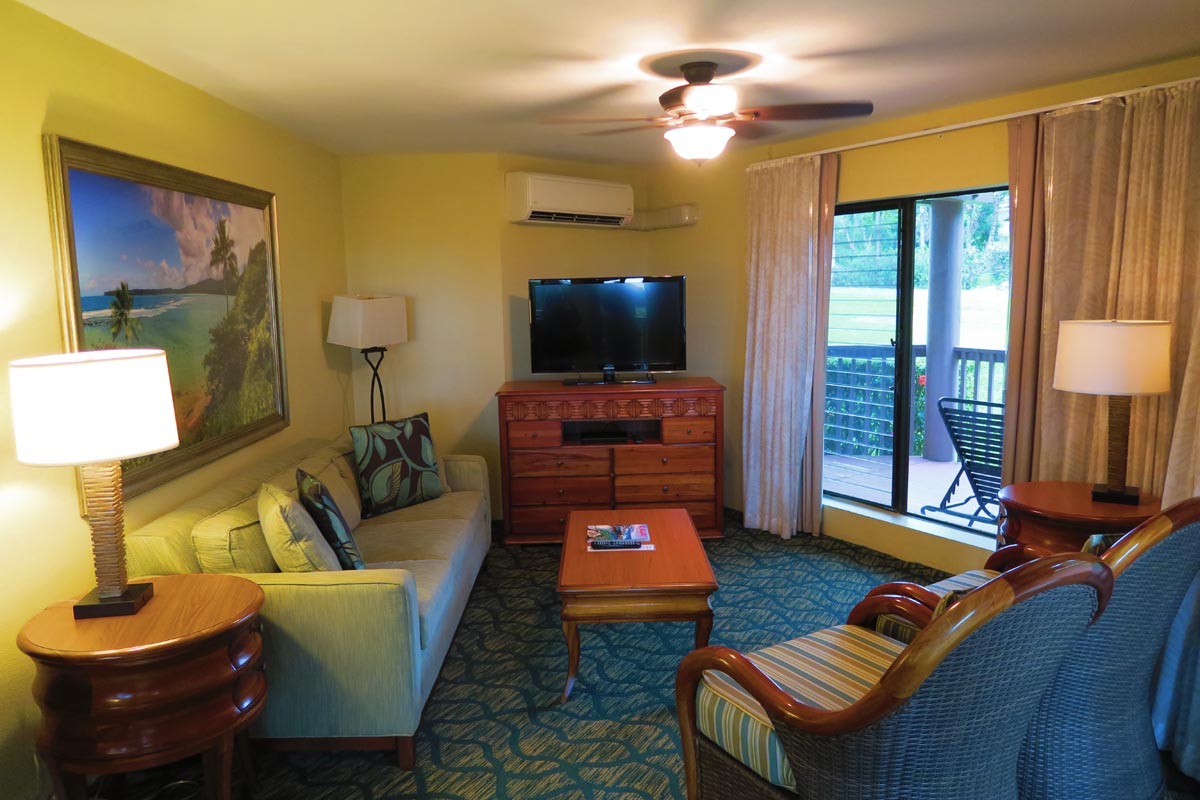
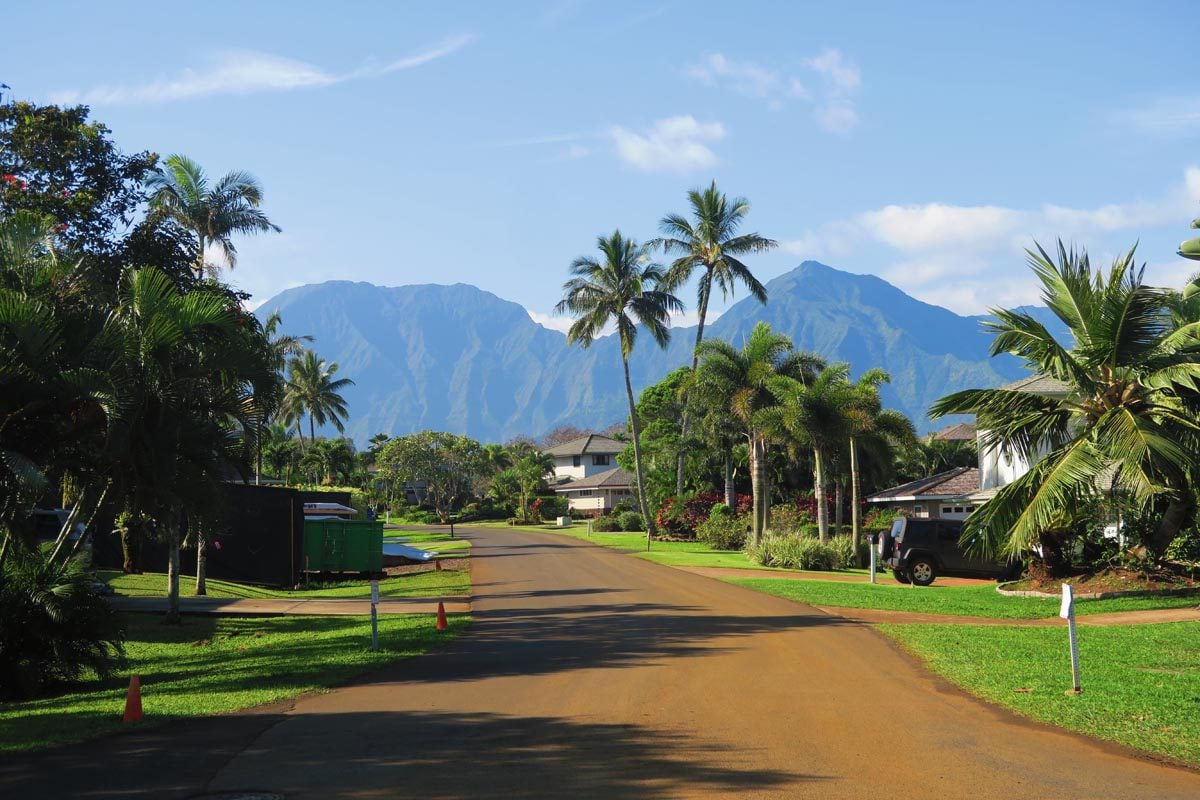
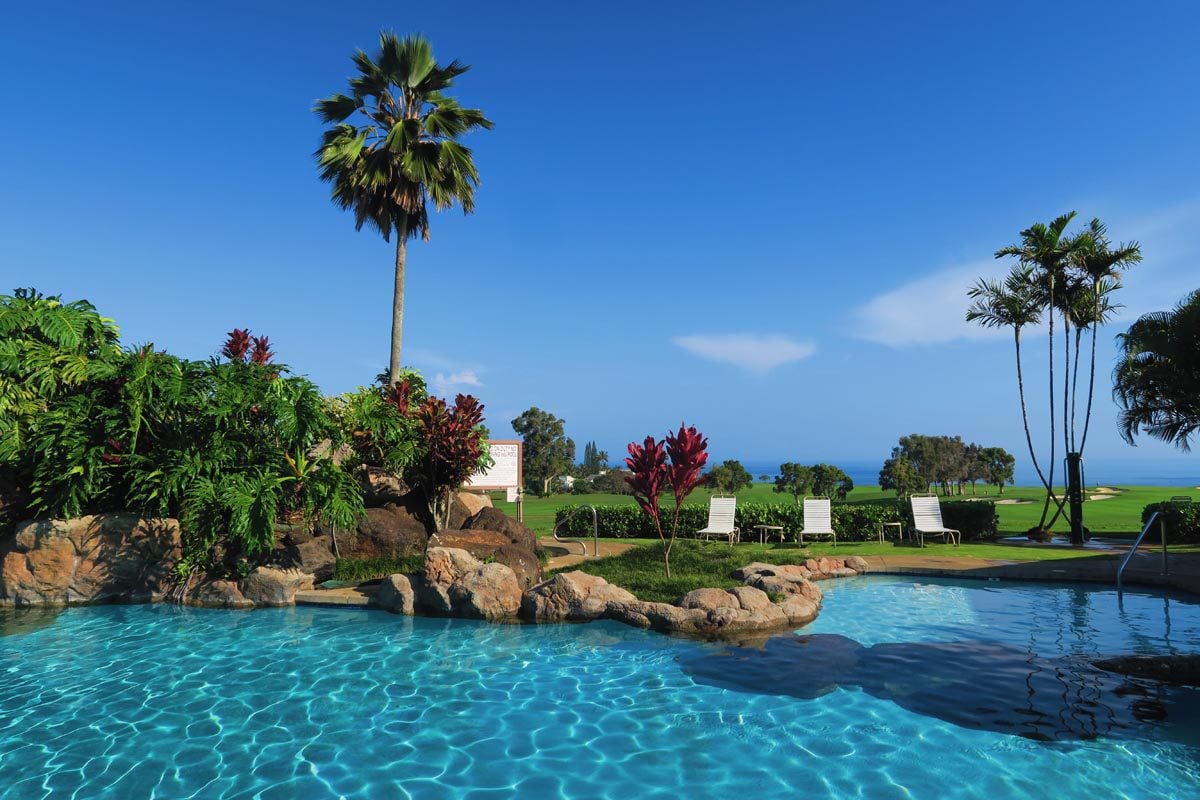
Weather in Kauai
Home to one of the wettest spots on the planet – Mount Wai’ale’ale – Kauai could never be this beautiful without the enormous amounts of rain it receives. With comfortable temperatures throughout the year, rain is the most significant factor in making or breaking your holiday. If you look at Kauai’s average weather, the drier months are April to September, and the wetter months are October to March, with heavy rainfall during the Christmas season.
However, Kauai has very interesting patterns. It is always wise to check the National Weather Center’s website the night before and switch your itinerary accordingly, though even this must be taken with a grain of salt. This weather forecast allows you to drill down into different island sections where the weather varies significantly.
Kauai’s northern mountain range generates a lot of precipitation that would otherwise ‘pass over’ the island. So much of the heavy rain tends to concentrate on the north shore and in the uninhabited interior. It usually rains in the form of a shower, but in some rare cases, the island sees constant rain for days and even weeks. Moreover, heavy rain tends to fall at night – for some reason – so you can expect very sunny mornings that warrant hitting the road early. This is also the best time to photograph the jagged peaks.
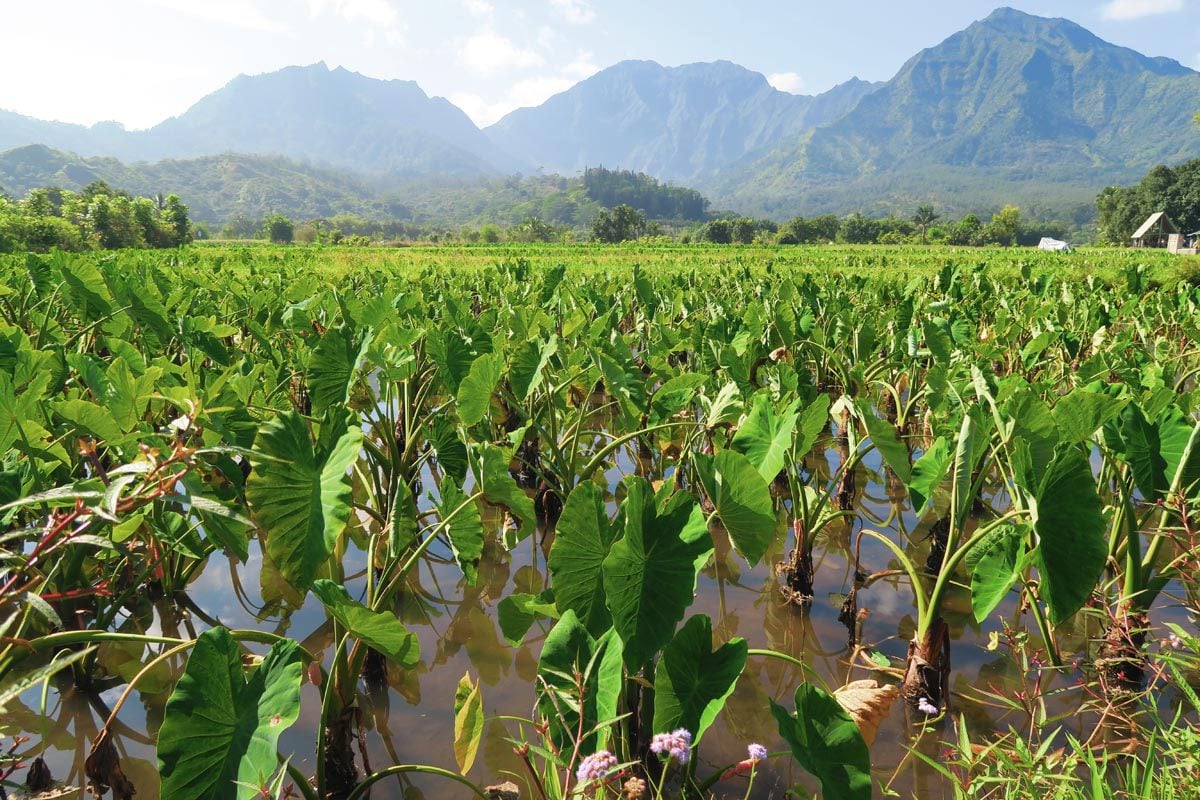
When I visited Kauai in March, the weather forecast called for heavy rain throughout the week. In reality, we enjoyed unusually sunny weather for the most part, and even when it did rain, once you passed Lihue heading south, the skies were completely clear. So, bottom line: try to avoid the super wet months, and in any case, drill down into the island’s weather forecast by specific area but with a critical eye.
Getting Around Kauai
I highly recommend renting a car from when you land in Kauai to when you leave.
Traffic in Kauai is quite an issue, especially during the peak tourist seasons. Roads to major attractions (Hanalei to Na Pali, for example) are often reduced to one lane in each direction and one-lane bridges. Traffic is also bad around the major “urban centers” of Lihue and Kapaa, with Kapaa’s traffic lights often causing major delays (use the bypass road). Kauai uses the contraflow system during morning rush hour traffic between Kapaa and Lihue to cope with the annoyance. Cones are placed on the road, adding another southbound lane at the expense of the northbound route.
If you have an early morning flight and heading to the airport from the north coast (Hanalei, Princeville, etc.), check driving times on Google Maps or Waze and leave extra time for unexpected delays.
Kauai by Car
Exploring Kauai by car is the most optimal option. The cost of renting a car in Kauai is quite reasonable, especially if you book well in advance. Note that the major car rental companies are located within Lihue airport grounds, while the smaller ones (like Fox) are outside and require using their shuttle, which doesn’t run 24/7.
Rental Car Insurance
The most important thing to remember and watch out for is the topic of insurance. Since Hawaii is a ‘no-fault’ state, car rental companies will scare you to death and offer costly insurance plans. With the larger companies, you can usually decline this, but with the smaller ones, they often force you to take, at the very least, the cheapest package, which greatly increases the total rental cost.
American car owners usually have an insurance policy that covers rental cars, but foreigners do not. If you’re traveling from abroad and renting from websites such as Rentalcars.com, purchase their affordable and comprehensive insurance policy.
A 4WD is not a must in Kauai unless you wish to visit Polihale State Park and Ha’ula Beach (remote beaches).
Kauai by Bus
Kauai does have a bus system consisting of small buses that run on several routes along the coast. However, it is not convenient for heavy sightseeing as it is geared more toward locals.
Hitchhiking & Cycling
Hitchhiking is quite common and safe in Kauai. However, if traveling solo, take extra care and use good judgment. Kauai’s coastline is quite flat for the most part, but I cannot recall seeing too many cyclists on the road.
What to Pack for Kauai?
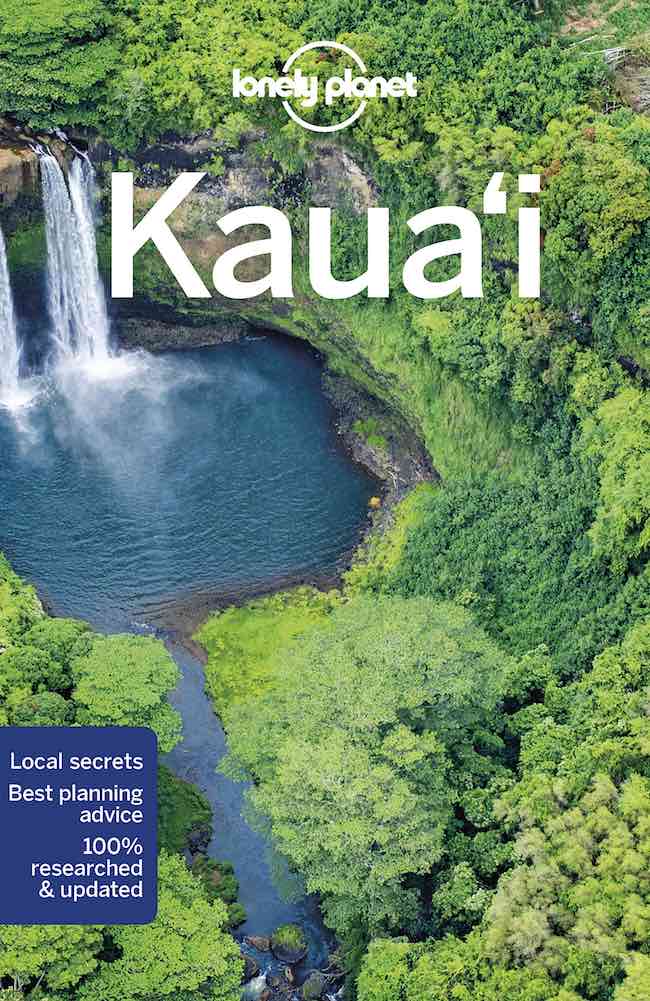
A visit to Kauai revolves mainly around the outdoors, with the rest of the time spent at the beach. You must pack proper hiking and rain gear, remembering that trails are often muddy and mosquitos are present. For example, pack good waterproof shoes, sweat-repelling clothing, light rain gear with a hat, camping gear if relevant, and even hiking poles. For the beach, it’s really just the usual stuff. Have a look at this page for more information and recommendations.
Together with this Kauai itinerary, I also recommend grabbing a Lonely Planet Kauai guidebook and, if visiting other islands, perhaps also Lonely Planet’s Best of Hawaii. These guidebooks provide useful information at your fingertips and give a better understanding of Hawaii’s culture and history. Needless to say, they make for a great souvenir in your travel library.
Are Scenic Helicopter Tours Worth It in Kauai?
Helicopter tours offer a unique vantage point over Kauai’s spectacular and often inaccessible wilderness. I seriously contemplated whether to join one of these but decided to opt out. Like everything in life, they have their pros and cons:
- Access to Kauai’s impenetrable interior on scenic tours, which include flying over (or landing) in Jurassic Park Falls.
- Unique vantage points to the Na Pali cliffs and Waimea Canyon.
- Possibility to experience the Na Pali cliffs and Waimea Canyon if you cannot hike those for physical reasons or if traveling with children.
- Awesome photos!
- Very (very) expensive.
- The actual flight time (i.e., the hovering) over the most scenic sections is very (very) minimal.
- You’ll likely be snapping photos ALL the time.
- Tours are often prone to cancellations, and certain departure times (ex: ‘early bird specials’) are often prone to poorer weather (i.e., clouds).
- You need to check the departure airfield and see if you are geographically close enough to explore by car or on foot after the scenic flight.
- It isn’t good for the environment: for people hiking the trails, the air quality, and most importantly, for the resident birds and animals.
- When sightseeing, do not leave anything visible inside your car or even in the trunk. Car break-ins are unfortunately common in some parts of some of the islands in Hawaii. Kauai is not as bad as other islands (like Maui) but it’s best to not tempt anyone.
- Cellular reception (including mobile data) is not that amazing, to say the least in Kauai. Therefore, ensure your accommodation has free wifi and download an offline Google Map of Kauai.
- Kauai beaches can be dangerous at times with high surf and strong currents. State parks will have proper warning signs and sometimes even lifeguards, but unofficial or remote beaches will not.
- Don’t be tempted to go for a swim in streams. These can often hide bacteria that can lead to nasty infections.
What to do in Kauai when it rains?
Kauai is blessed with a lot of rainfall, as we’ve already covered. On days with heavy rain, here are a few activities to consider.
- Head to the south of Kauai. This is the drier side of the island, and it is possible that while it’s raining in Hanalei, it’s sunny in Poipu. If a major storm strikes the island, this “trick” won’t hold.
- Visit the Kauai Museum in Lihue and learn about the island’s history. You might also be able to join traditional workshops.
- Join a guided tour of Kauai Coffee Company Estate and learn about the island’s coffee-making history.
- Visit the Grove Farm Museum and learn about the history of sugar cane production in Kauai, a major industry back in the day.
- Tour the Kilohana Plantation. This is also the site of the Luau Kalamaku show.
- Visit the Waioli Mission House in Hanalei. This beautiful and historic building showcases the history of missionary work on the island.
Day 1: Lihue, Poipu and Hanapepe
We’ll start the Kauai itinerary on the sunny south shore with a road trip combining historical towns, coastal hikes, and beaches. It doesn’t really matter if you follow this itinerary from east to west (starting in Lihue) or from west to east (starting in Hanapepe).
Days 1 and 2 of this Kauai itinerary are optimal when you’re based on the south shore. If you’re staying in the north shore, simply account for longer driving times when planning your day.
Around Lihue
Lihue is the largest town in Kauai, and it is here that you’ll find fast-food joints, shopping centers, large supermarkets, and everything else a small town has to offer. There are no must-see tourist attractions in Lihue, but check if your visit coincides with either the bustling Kauai Community Market (Saturday morning) or the smaller Pua Hana Market (Monday afternoon) and Kauai Sunshine Market (Wed/Thu). Here’s a good list of all Kauai farmer’s markets.
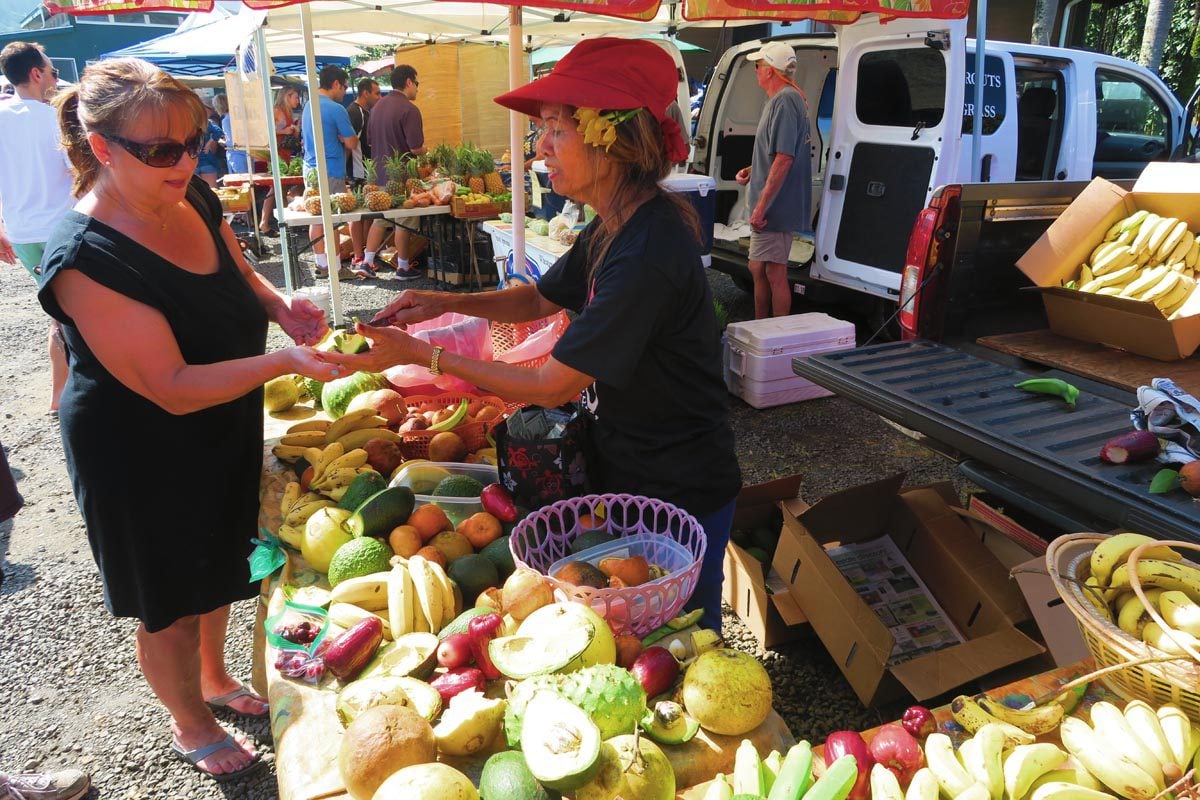
Menehune Fishpond Overlook
The Menehune Fishpond Overlook is a brief scenic stop away from the main highway, revealing sweeping views of the Hule’ia Valley and the river that cuts through it. In ancient times, the river was dammed to form a large pond. The best time to visit the overlook is just before sunset, as the changing lights from the setting sun illuminate the valley. However, you can easily come back here for sunset (and drinks at Duke’s Bar) but only if the skies are clear.
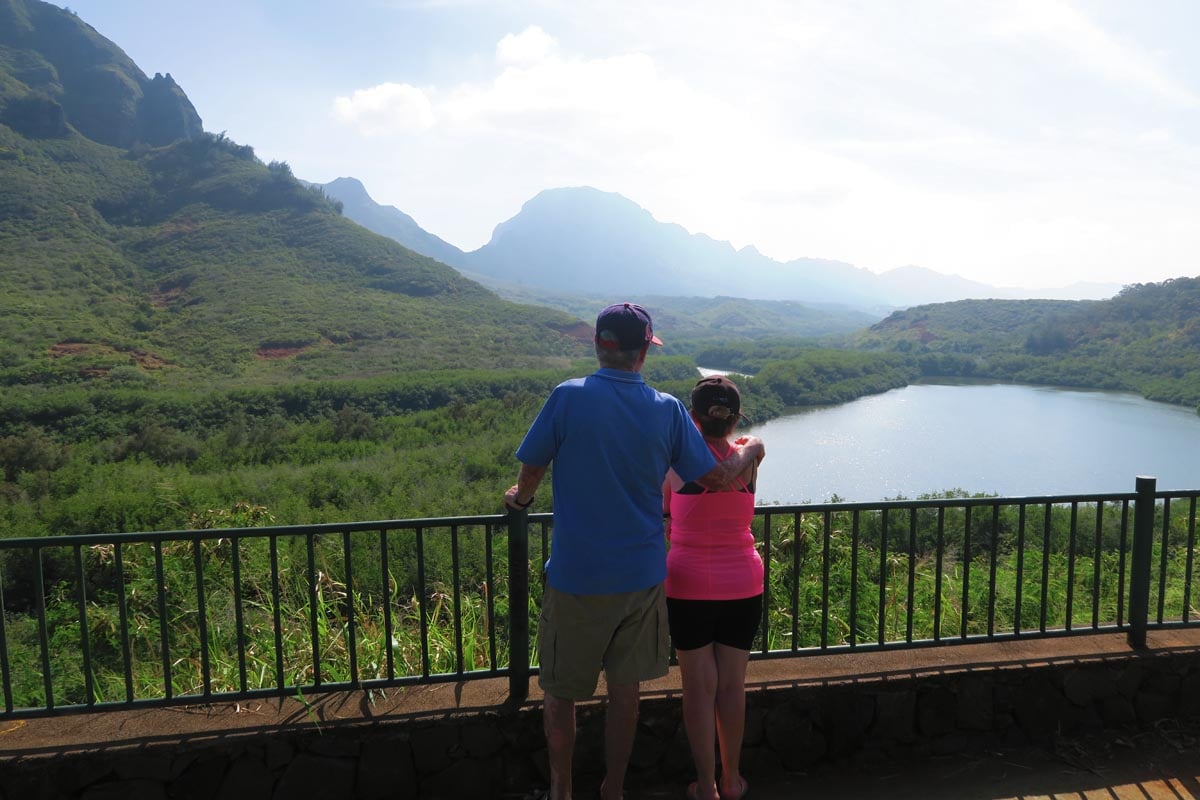
Tunnel of Trees
Right after the turnoff to Maluhia Rd (Highway 520) from the main highway (Highway 50), you’ll drive through a brief tree-covered section rightly nicknamed the ‘tunnel of trees’. It’s about a mile long, enchanting and astounding, and, in case you were wondering – man-made. For the best photo op, pull over at the fork.
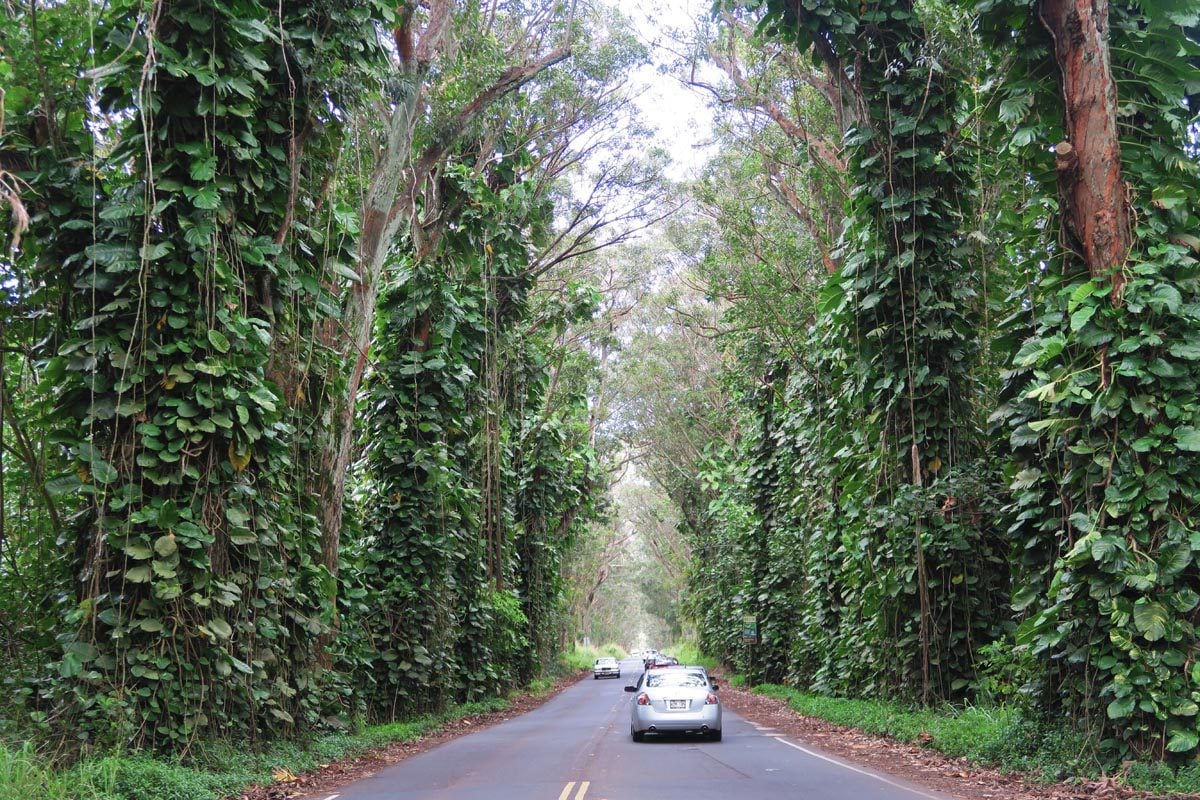
Old Koloa Town
Home to Hawaii’s first sugar mill (1835), Old Koloa Town is on your way, so you might as well stop and look around. A former plantation town that’s been carefully restored into a tourist shopping complex, you’ll find here a small museum explaining the region’s history, souvenir shops, and eateries. You can also time your visit to the historic town and the area to coincide with one of the Koloa Farmers Markets.
Personally, I wasn’t a huge fan of all these ‘historic towns’ in Hawaii. You find them on almost every island. Sure, they are historical, but nowadays, they’re essentially just a collection of tacky souvenir shops. I do recommend stopping by the Koloa Fish Market for some lunch to go (excellent poke bowls and traditional Hawaiian plate lunches).
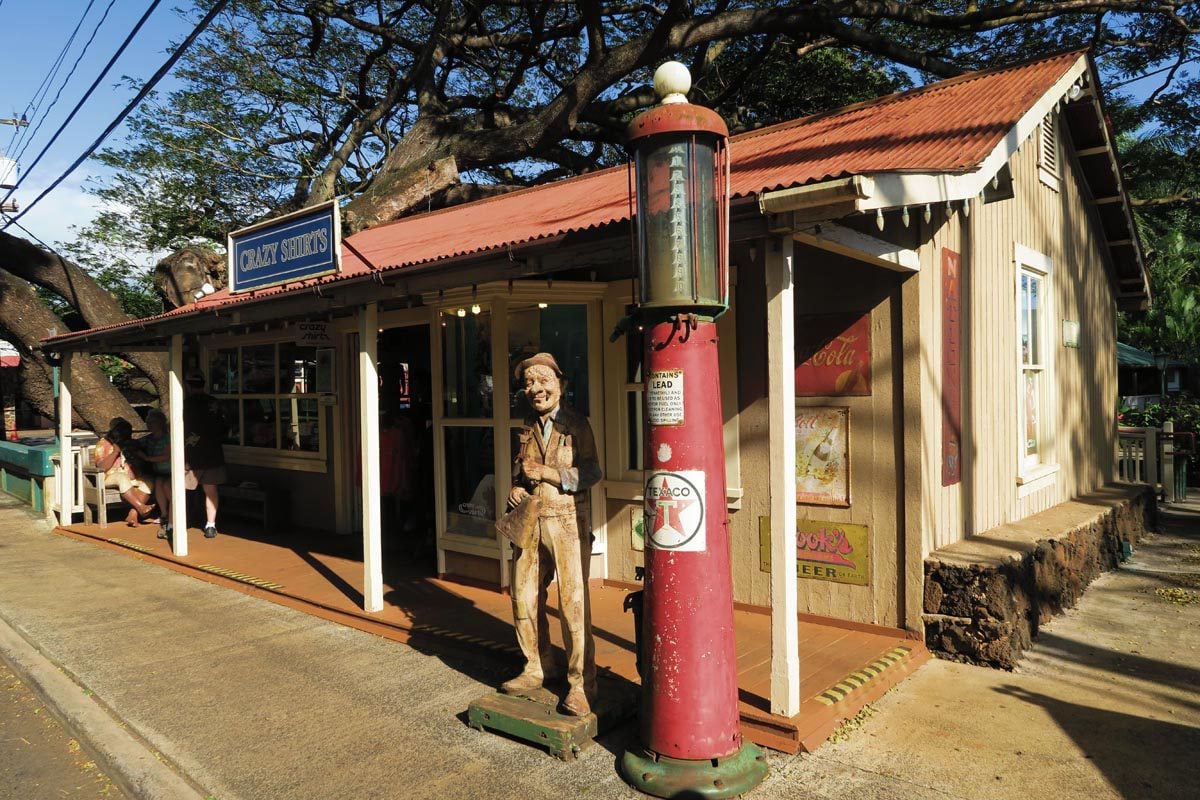
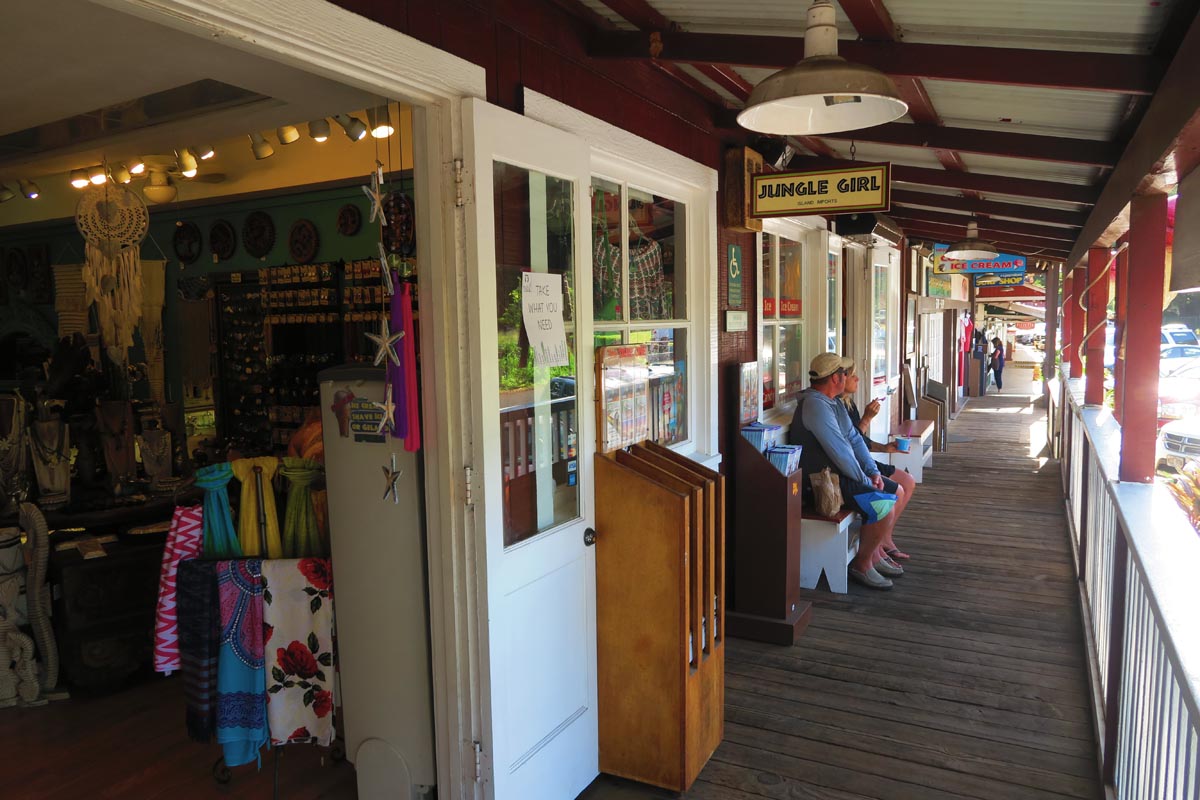
Shipwreck Beach
This would be the south coast’s prettiest beach if it weren’t for the massive Grand Hyatt resort, which reminds you we’re still in America after all. Nonetheless, Shipwreck Beach is one of the best beaches in Kauai, blessed with soft golden sand and a shaded picnic area. Though the water looks very inviting, swimming can be very hazardous, so perhaps just work on your tan, have lunch, and rest before the (optional) upcoming hike.
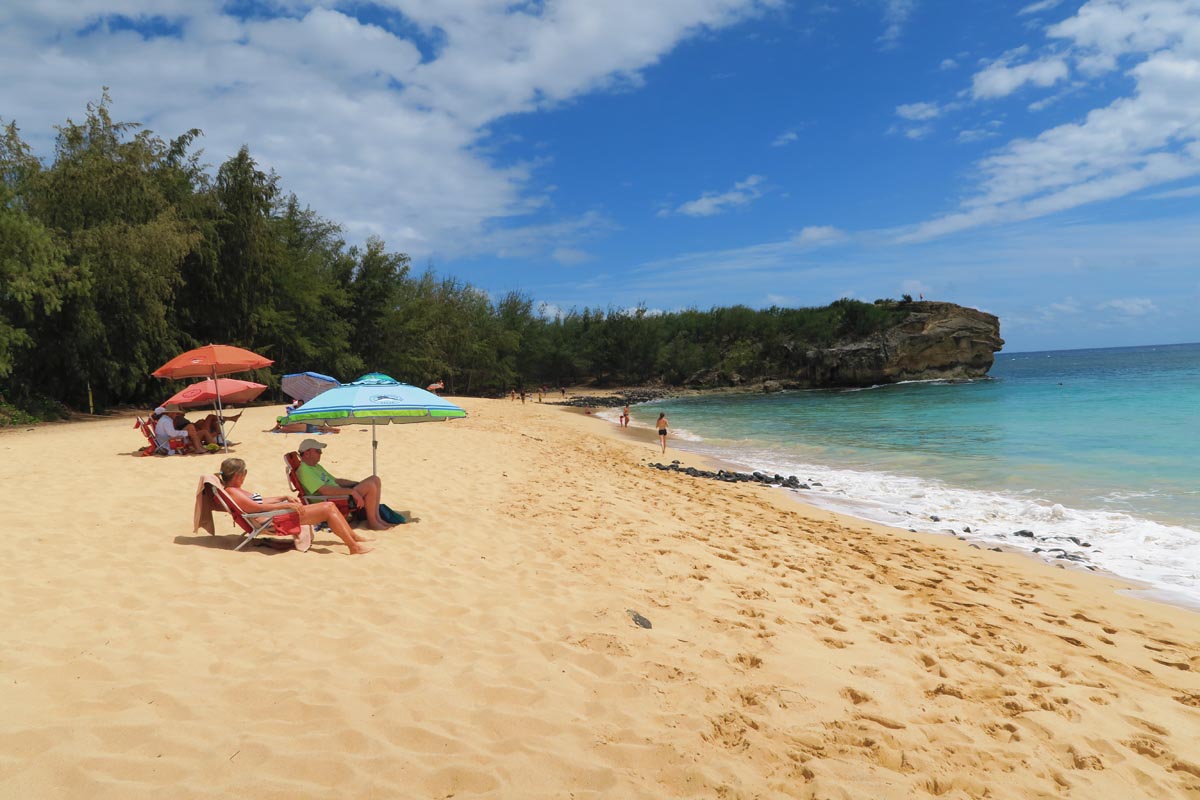
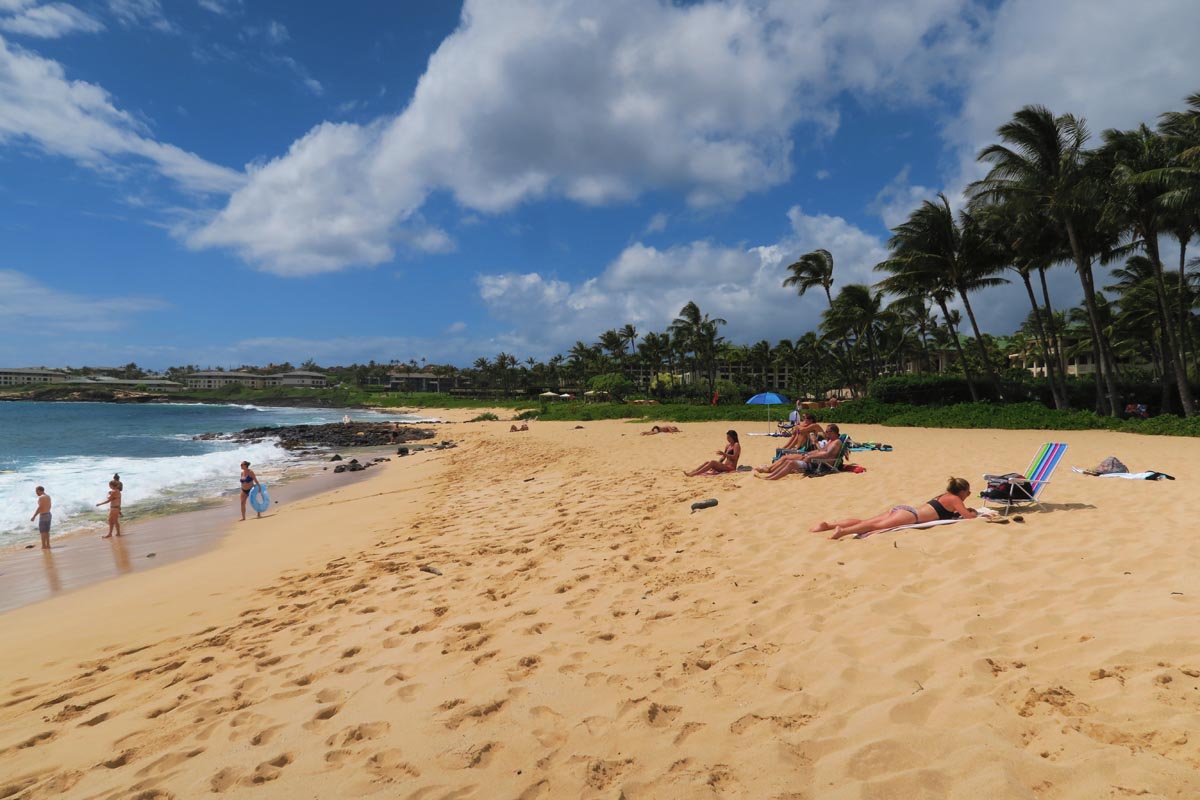
Mahaulepu Heritage Coastal Trail
Likely the highlight of the day, it’s time to slip into your hiking shoes and embark on a leisurely scenic hike along the coastline on the Mahaulepu Heritage Coastal Trail. The trail starts at Shipwreck Beach and ends two miles east in remote Ha’ula Beach (you can drive here with a 4WD), but you can hike for as long as you want and return the same way.
The trail begins with a brief climb to Makawehi Point via the ironwood forest. From here, you’re treated to panoramic views of Shipwreck Beach and the rugged coastline which you’ll now be hiking along. The cliff is also a favorite spot for locals and overconfident tourists who bravely (or foolishly) take the plunge.
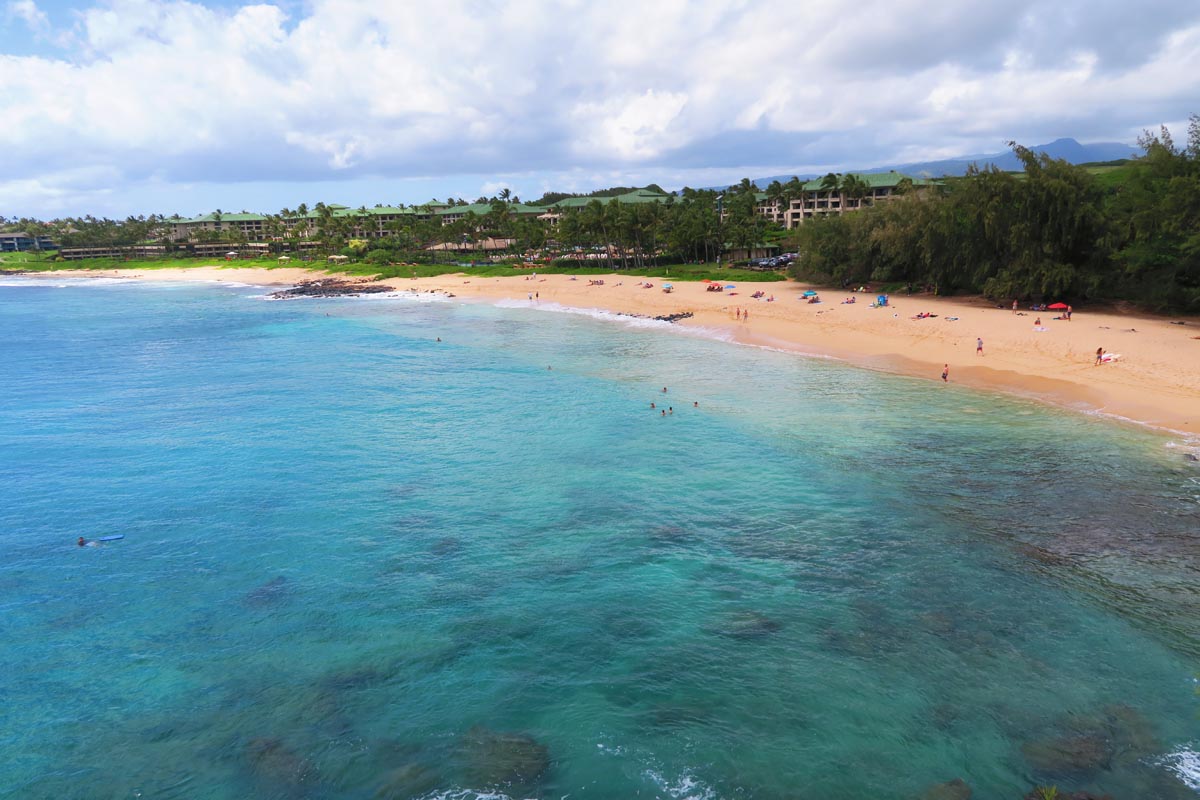
From Makawehi Point, the hike is mostly flat, and even if you veer off the sandy main trail, the general direction is pretty clear. Before the halfway mark, you’ll reach a gorgeous cove that’s hugged by sharp limestone pinnacles. On this side of the island, the strong winds have beautifully sculpted the eroding limestone in magnificent works of natural art and it is all yours to enjoy with very few people on the trail.
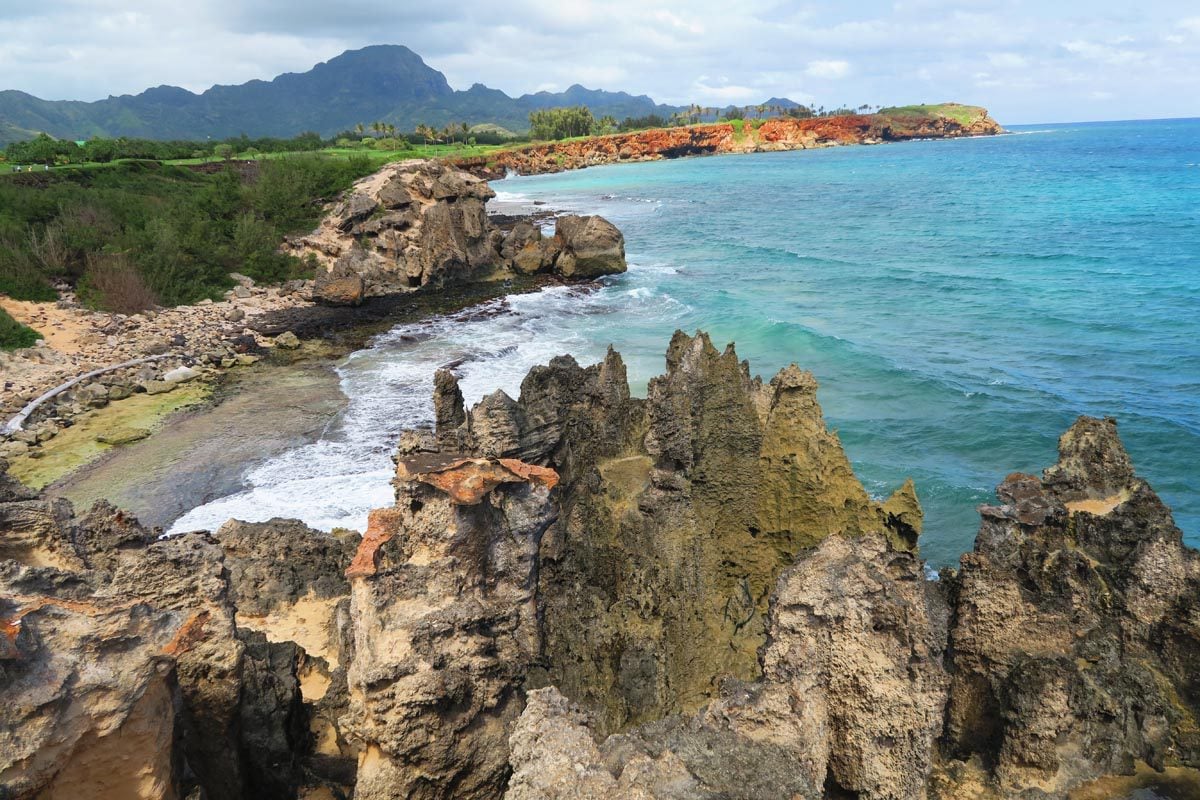
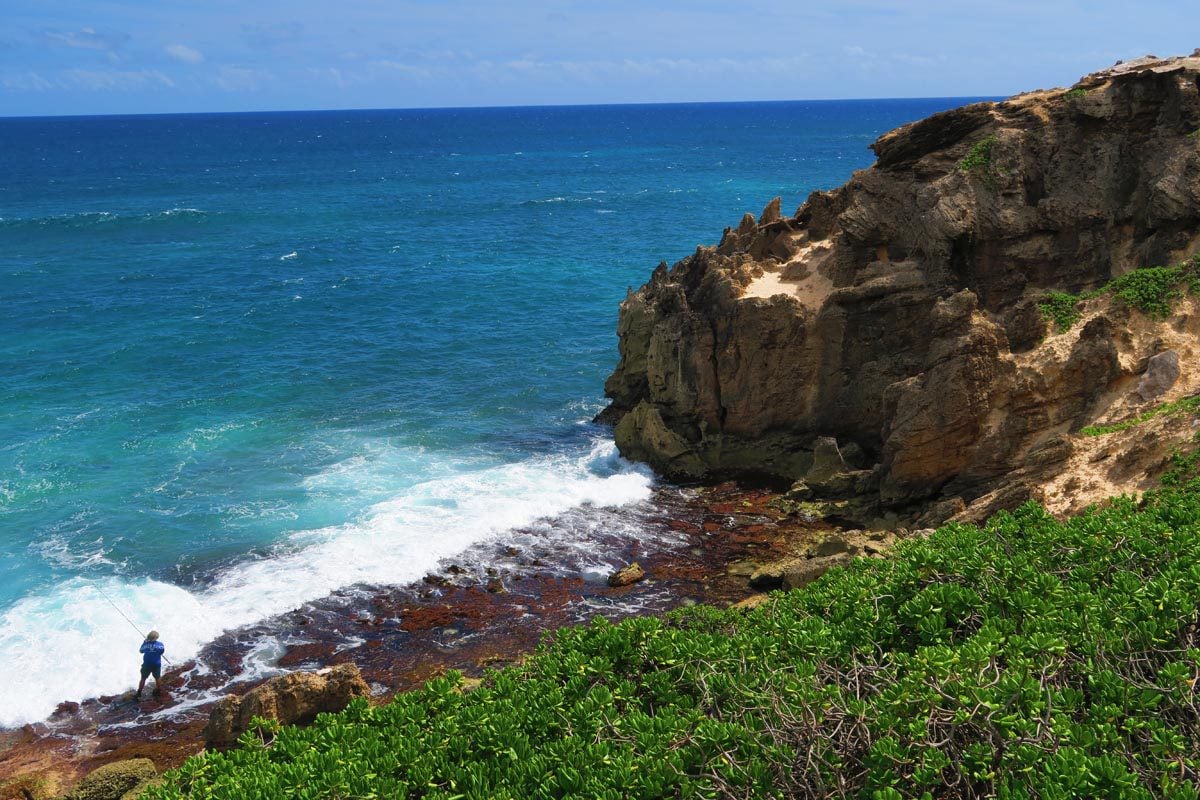
Moving along, you’ll pass by the sacred remnants of an ancient Hawaiian stone structure as you round the golf course. It is here that you might, with a bit of luck, spot sea turtles cruising up and down the coast. You can turn around or continue to Makauwahi Cave, Mahaulepu Beach, and even further to Ha’ula Beach.
Logistics: wear comfortable walking shoes, bring lots of water, and wear a hat, as there’s no shade along the trail.
Makauwahi Cave
The Makauwahi Cave is one of Kauai’s coolest spots. Reached via a giant sinkhole, the cave is considered one of the richest fossil sites in Hawaii and perhaps the entire Pacific. Through years of detective work, researchers partially managed to peel the layers of mystery around the religious rituals performed on this site by ancient Hawaiians. They also discovered rare animal species, fossil remains, and peculiar “magic tricks” performed by algae. This place is so unique and beautiful that even Hollywood took notice. Scenes from Pirates of the Caribbean and one Indiana Jones film were shot here!

In late 2024, the Makauwahi Cave closed until further notice. Check the official website for updated before planning your visit.
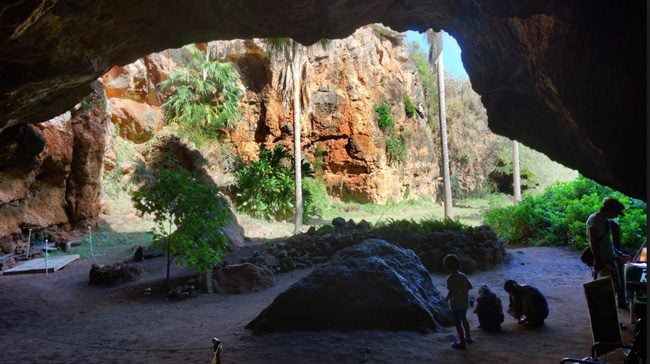
Mahaulepu Beach
A short walk from the cave brings you to Lida’s Field of Dreams, a private conservation project where you can get closely acquainted with large turtles. From here, it’s a stone’s throw away to Mahaulepu Beach (a.k.a Gillin’s Beach). It’s one of the wildest beaches in Kauai, where clothing is optional, and snorkeling is good at its western edge when the ocean is calm.
Come here to chill, swim, snorkel, or just for a quick stroll, but bring everything you need because there’s nothing man-made besides a historic off-the-grid home. On some days (especially after storms), beach water might be contaminated from the nearby stream, but there will be signs in such cases.

Logistics: you can reach the cave and beach via the Mahaulepu Heritage Coastal Trail or drive here on the dirt road, which begins right after the Grand Hyatt. When you reach a gate, turn right and park along the fence of the horse ranch.
Poipu to Hanapepe
It’s about a 25-minute drive from Poipu to Hanapepe – the last leg of the day. After all that walking and soaking in the sun, make a pit stop at The Fresh Shave Ice. It’s the best shave ice in Kauai. At mile marker 14, stop at the signposted Hanapepe Valley Lookout and catch a preview of the spectacular scenery waiting for tomorrow’s trip to Waimea Canyon. The lush Hanapepe Valley is prime agricultural land and you should already spot the reddish color of the soil that you’ll be more acquainted with tomorrow.
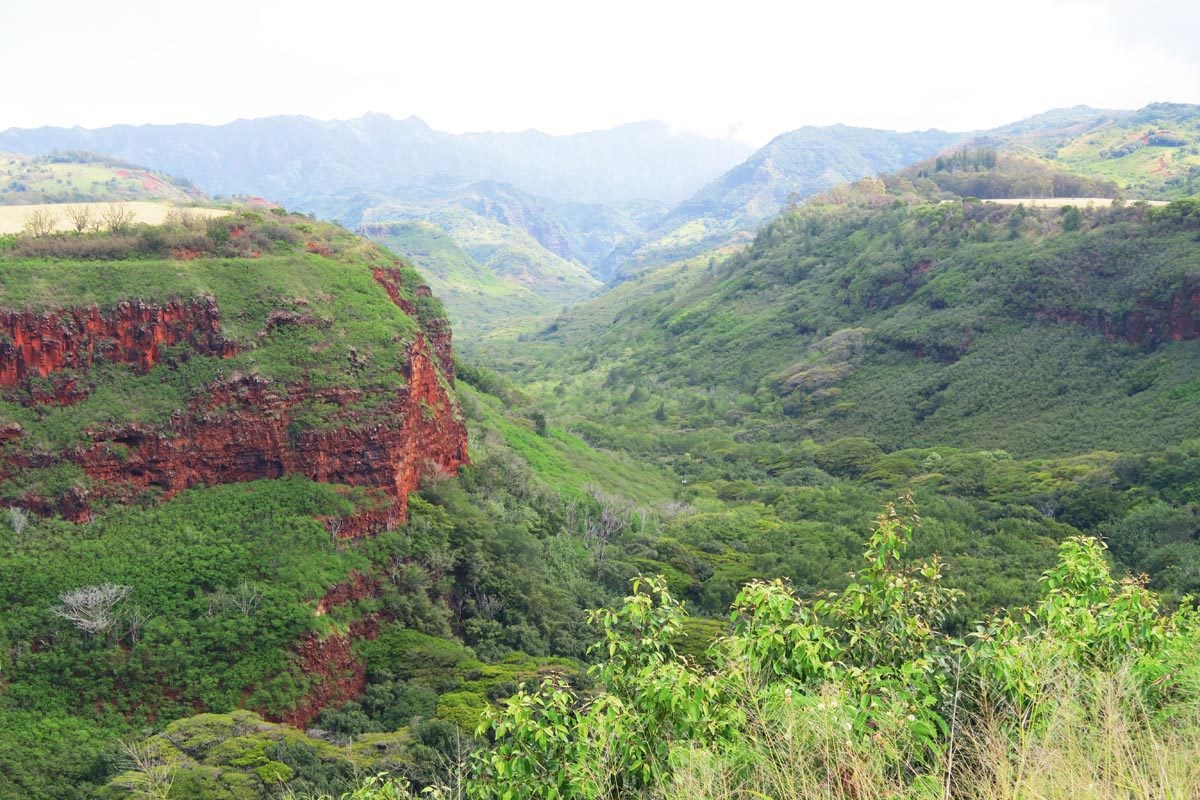
Hanapepe
Dubbed ‘Kauai’s Biggest Little Town’, Hanapepe is just a tiny village. Hanapepe was a prosperous place back in the sugar plantation era. Today, Hanapepe is very laid back, attracting young residents who appreciate the sunshine and lack of noise. Over on the main street, Hanapepe’s old wooden structures have been well maintained, and a rich art scene has developed.
Hanapepe is a nice place to stop and stretch your legs and even to base yourself if you want to enjoy the Poipu sunshine without the crowds. For an extra bit of fun, cross the Hanapepe Swinging Bridge. As far as dining, Hanapepe has plenty of options, ranging from casual to formal, and even excellent taro chips at Taro Ko Farm.
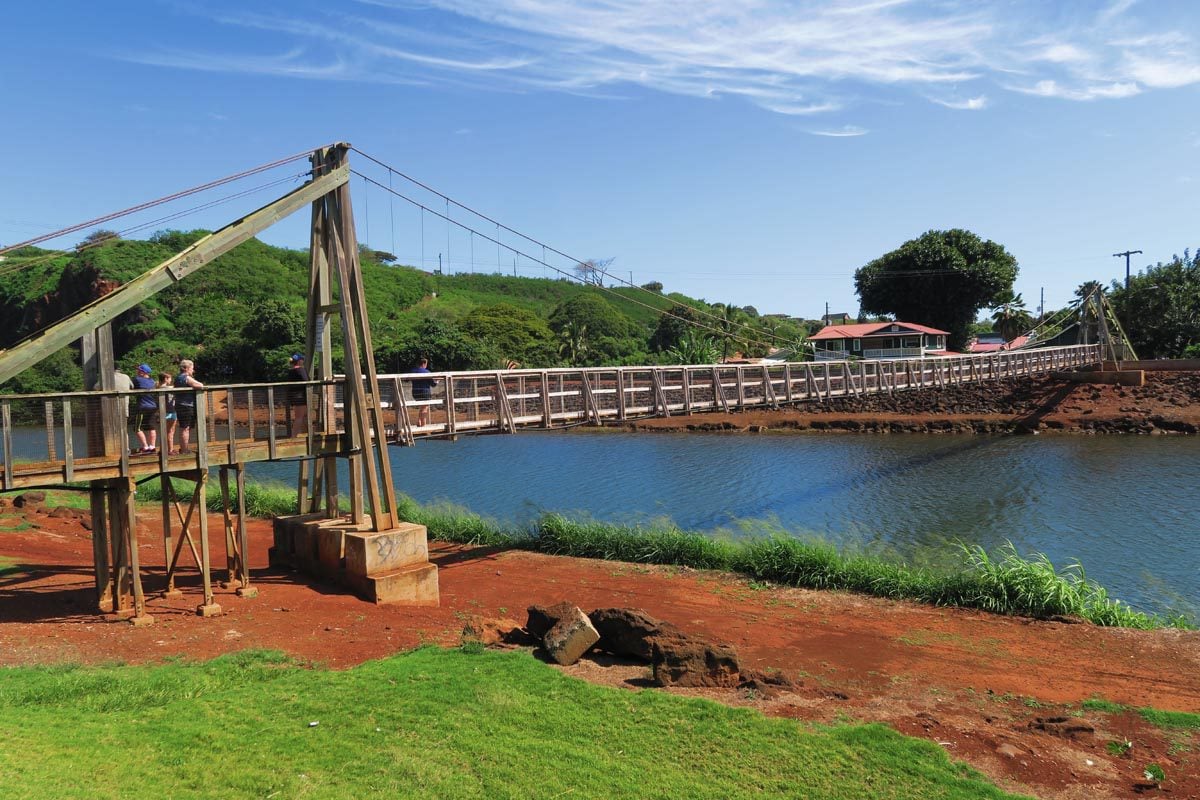
Sunset in Salt Pond Beach
Celebrate your first day of sightseeing in Kauai with a magical sunset in Salt Pond Beach Park. The beach is quite popular with locals and got its name thanks to the nearby salt ponds that are still in use today. There’s a beautiful crescent of golden sand, palm trees that sway in the gentle wind, and even a small rocky tide pool for the kids. On a clear day, the forbidden island of Ni‘ihau can be seen in the distance.
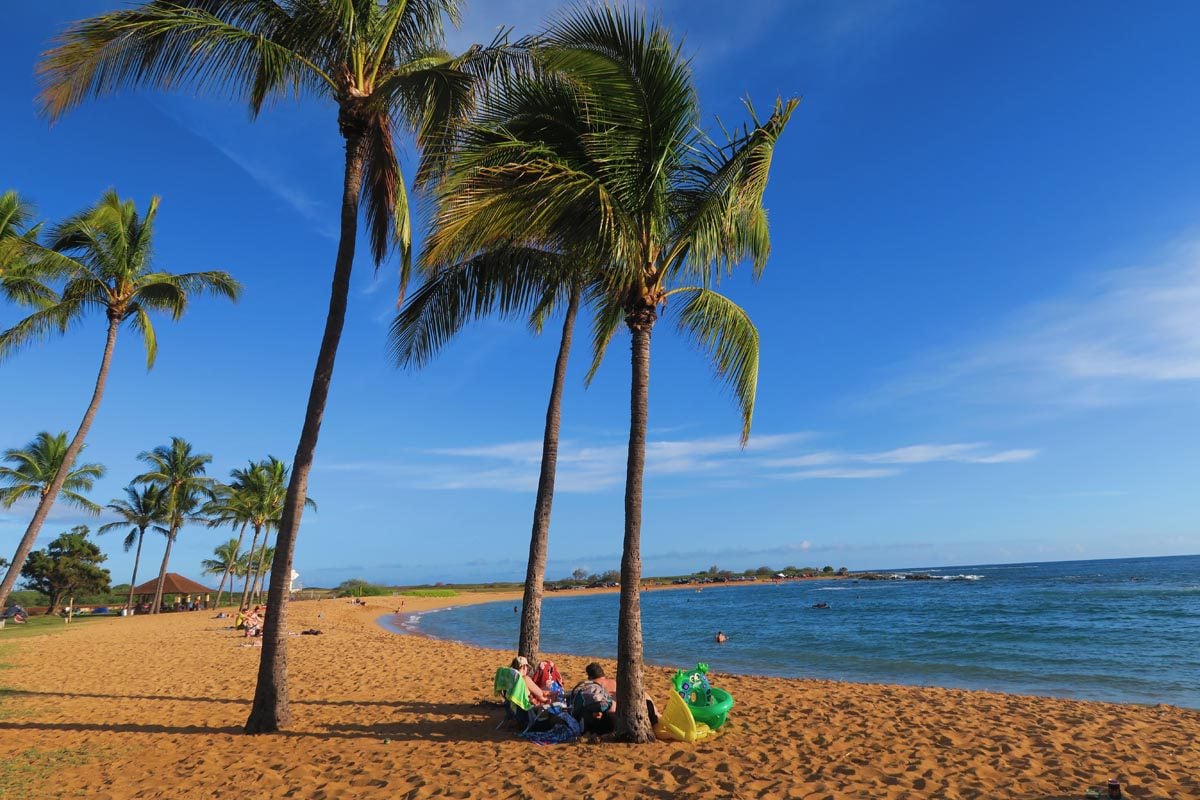
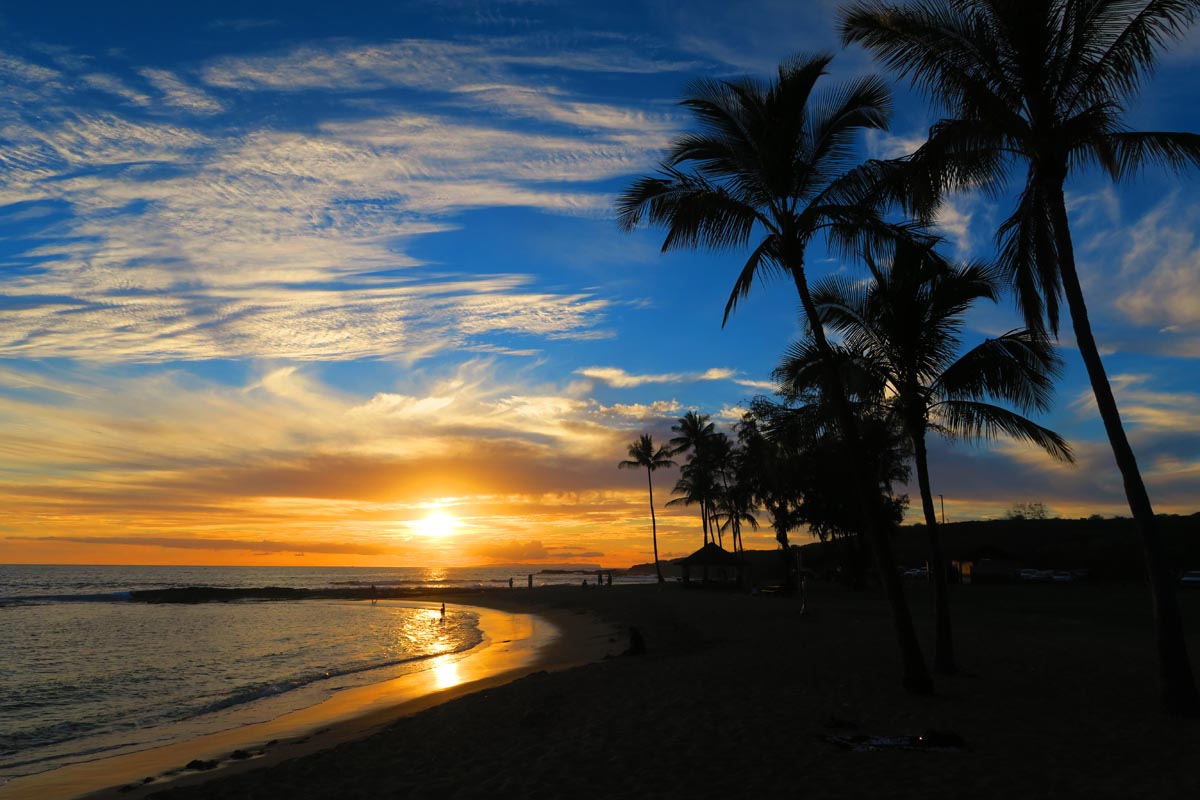
If its still daylight and you’re up for more sightseeing, check out the peculiar Glass Beach. Thanks to a nearby recycling plant, the sand has pretty much been taken over by tiny pebbles of glass in various colors.
